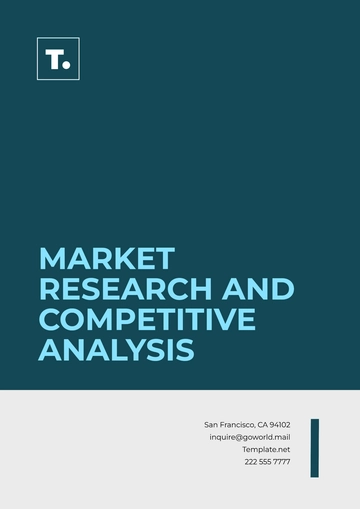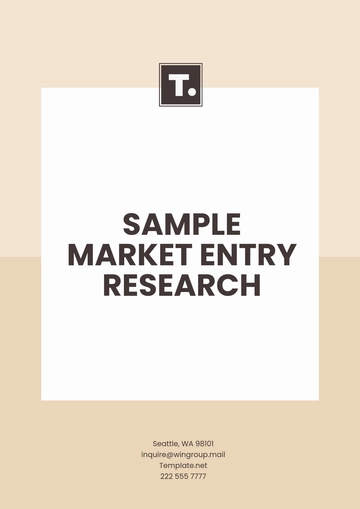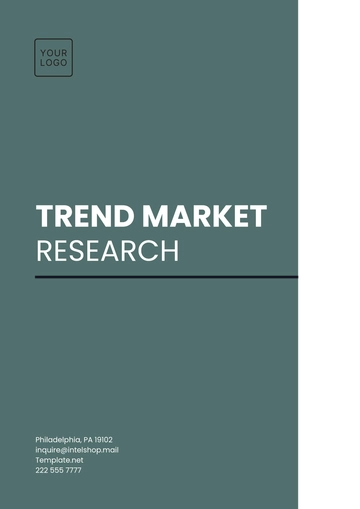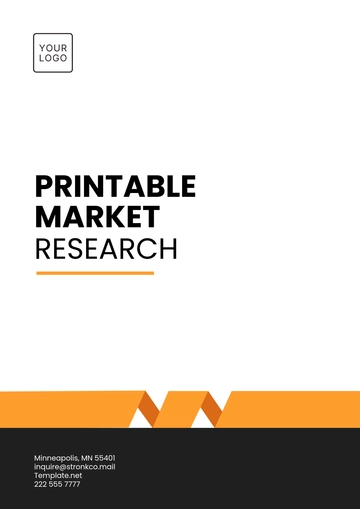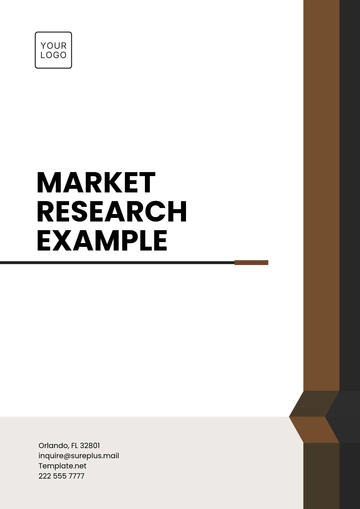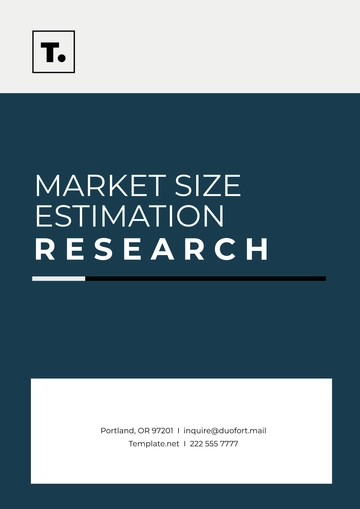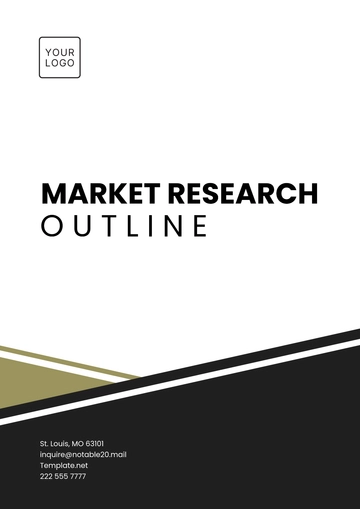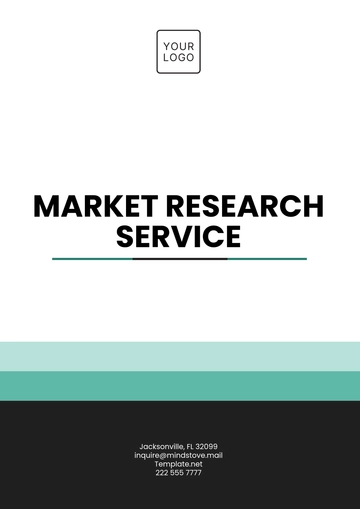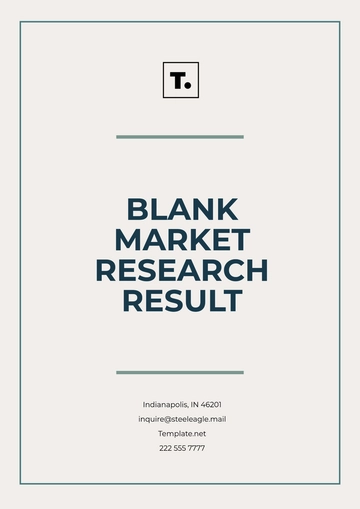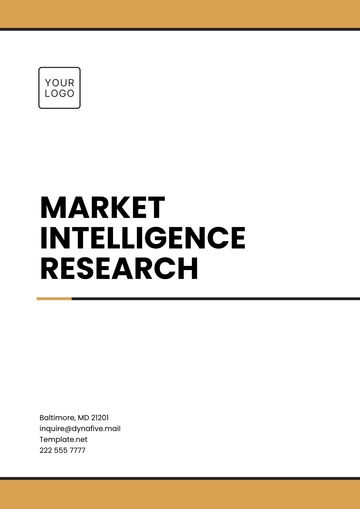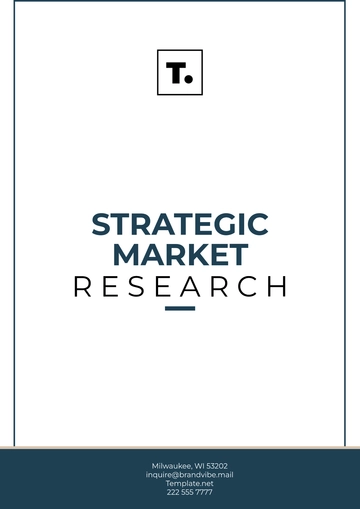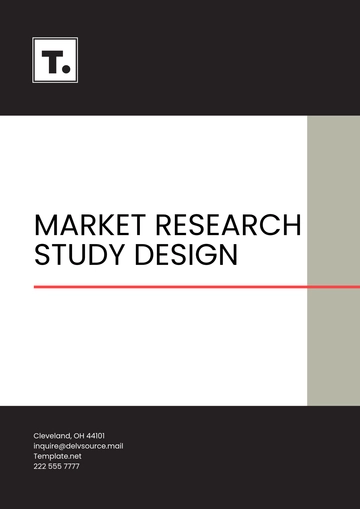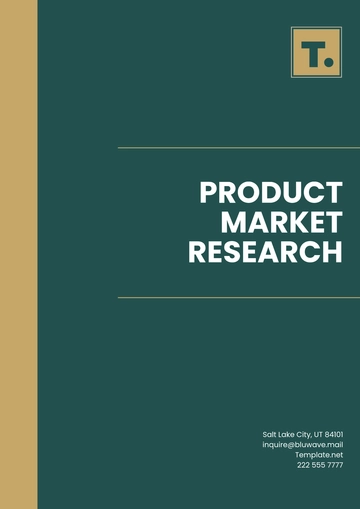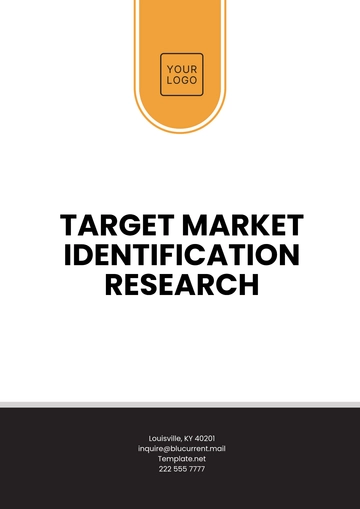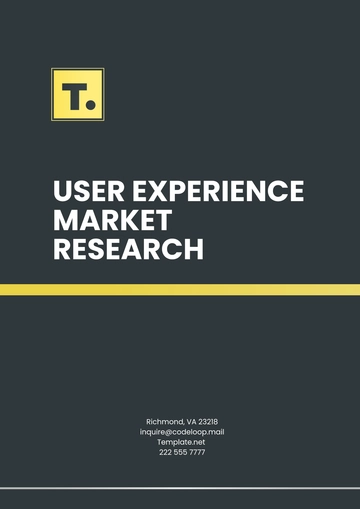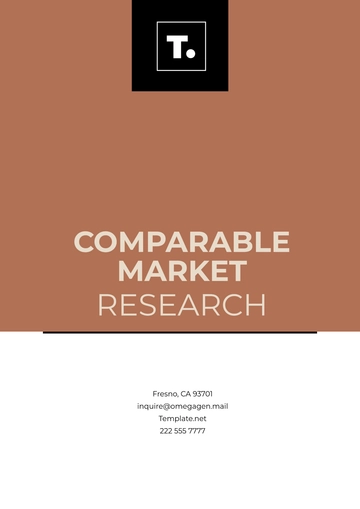Free Agriculture Supply Research
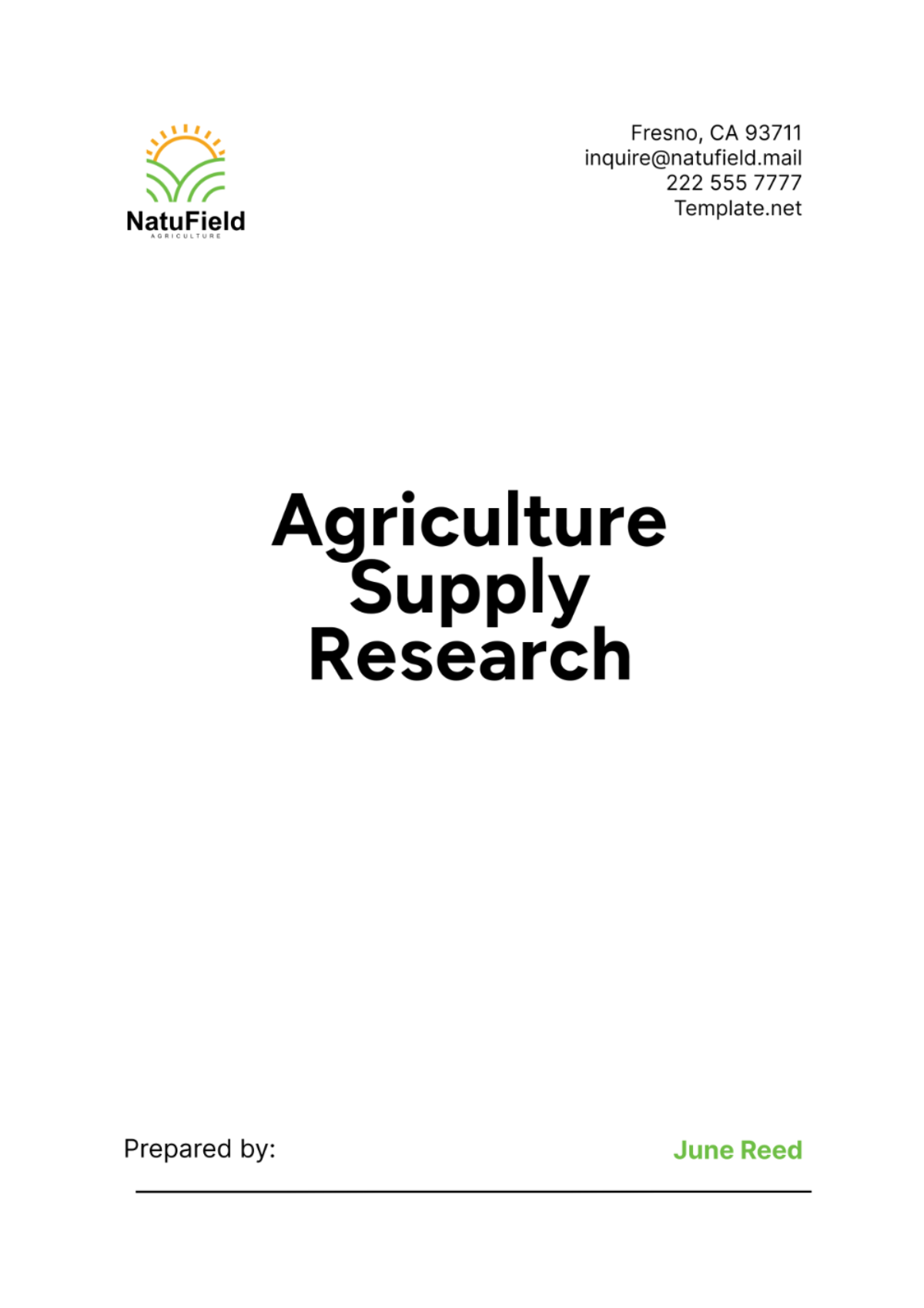
1. Introduction
The objective of this Agriculture Supply Research is to comprehensively analyze the current supply chain of agricultural equipment and materials to enhance operational efficiency and productivity at [Your Company Name]. This research aims to identify reliable suppliers, assess the quality and cost-effectiveness of agricultural supplies, and explore innovative technologies that can be integrated into our supply chain.
By understanding market trends and supplier capabilities, we intend to secure sustainable and competitive sourcing strategies. The study also seeks to mitigate risks associated with supply chain disruptions and ensure consistent availability of critical equipment and materials. Ultimately, the research will provide actionable insights to support strategic decision-making and optimize resource management in our agricultural operations.
2. Identification of Reliable Suppliers
Identifying reliable suppliers is a cornerstone of our research. By conducting a thorough analysis of potential suppliers, we aim to establish partnerships that ensure a steady supply of high-quality agricultural equipment and materials.
This section will cover:
Evaluation criteria for selecting suppliers
Supplier performance metrics
Supplier audits and assessments
Evaluation Criteria for Selecting Suppliers
Criteria | Description |
|---|---|
Quality Standards | Evaluate suppliers based on adherence to industry-specific quality standards. Ensure products meet regulatory requirements and customer expectations for performance and durability. |
Reliability | Assess the supplier's track record for reliability, including on-time delivery performance metrics. Determine their ability to consistently meet scheduled delivery dates and maintain product availability. |
Cost-effectiveness | Compare pricing structures among potential suppliers while considering the total cost of ownership, including shipping, taxes, and potential customs duties. Aim for competitive pricing without compromising on product quality. |
Flexibility | Evaluate the supplier's capability to accommodate fluctuations in demand, including peak seasons and unexpected order surges. Assess their responsiveness to urgent orders and flexibility in adjusting delivery schedules. |
Ethical Practices | Conduct due diligence on ethical sourcing practices, including labor conditions, environmental sustainability, and compliance with international standards (e.g., Fair Trade, ISO certifications). Ensure suppliers align with our corporate social responsibility (CSR) policies. |
Location | Consider the geographical proximity of suppliers to our operational facilities. Evaluate transportation logistics and associated costs to minimize lead times and transportation expenses. |
Financial Stability | Assess the financial health and stability of potential suppliers through financial statements, credit reports, and payment history. Ensure suppliers have the financial capacity to fulfill contractual obligations and sustain long-term partnerships. |
Supplier Performance Metrics
Metrics | Description |
|---|---|
On-time Delivery Rate | Percentage of deliveries made on or before scheduled delivery dates. Track performance over a specified period to assess consistency and reliability in meeting deadlines. |
Quality Acceptance Rate | Measure the percentage of products that meet our quality standards upon delivery. Conduct regular quality inspections and audits to ensure products conform to specified requirements. |
Lead Time Variability | Evaluate the consistency in lead times from order placement to delivery. Monitor lead time variability to identify trends and potential areas for improvement in supply chain efficiency. |
Customer Satisfaction | Gather feedback from internal stakeholders, including procurement teams and end-users, to assess satisfaction with supplier responsiveness, service quality, and problem-solving capabilities. |
Complaint Resolution | Track the efficiency and effectiveness of the supplier's process for resolving issues or complaints related to delivered goods. Monitor response times and corrective actions taken to address identified concerns. |
Supplier Audits and Assessments
Audit/Assessment | Frequency | Responsible Party | Objective |
|---|---|---|---|
Quality Audits | Annually | Quality Assurance Team | Conduct comprehensive audits to verify adherence to agreed-upon quality standards and regulatory requirements. Identify areas for improvement and corrective actions. |
Financial Assessments | Biannually | Procurement Department | Assess the financial stability and viability of suppliers through detailed financial analyses, including liquidity ratios, profitability, and debt management. |
Ethical Compliance Checks | Quarterly | Sustainability Officer | Verify compliance with ethical sourcing practices, including labor rights, environmental sustainability, and social responsibility initiatives. Ensure alignment with our corporate values and ethical standards. |
This structured approach to identifying reliable suppliers will enable [Your Company Name] to establish robust partnerships that support our operational goals and ensure consistent access to high-quality agricultural equipment and materials. By leveraging detailed evaluation criteria, performance metrics, and regular audits, we aim to mitigate risks, optimize supply chain efficiency, and enhance overall operational resilience.
3. Quality and Cost-Effectiveness Assessment
Assessing the quality and cost-effectiveness of agricultural supplies is crucial for maintaining high operational standards and optimizing resource allocation. This section will delve into:
Quality control measures
Cost analysis and benchmarking
Long-term cost savings strategies
Quality Control Measures
Measure | Description |
|---|---|
Incoming Inspection | Upon receipt of agricultural supplies, our quality assurance team conducts detailed inspections using standardized checklists. This ensures that products meet our stringent quality standards for durability, performance, and safety. We sample products according to ANSI/ASQC Z1.4-2003 standards, testing parameters such as material strength, chemical composition, and dimensional accuracy. |
Testing Protocols | We have developed rigorous testing protocols aligned with ASTM and ISO standards to evaluate the quality and reliability of agricultural supplies. Testing includes stress tests, environmental simulations, and reliability assessments to ensure products withstand harsh agricultural conditions and meet regulatory requirements. |
Supplier Qualification | Our supplier qualification process includes comprehensive assessments of supplier capabilities, quality management systems, and adherence to international quality standards (e.g., ISO 9001). Suppliers must demonstrate a commitment to continuous improvement and provide certifications for materials used in production. |
Quality Assurance | To maintain consistent product quality, we implement a robust quality assurance program. This includes regular audits of suppliers' manufacturing processes, product inspections throughout the supply chain, and feedback mechanisms to address quality issues promptly. We utilize statistical process control (SPC) methods to monitor production variability and ensure conformity to specifications. |
Cost Analysis and Benchmarking
Analysis/Benchmarking | Description |
|---|---|
Cost Breakdown Analysis | Our cost breakdown analysis examines all components contributing to the total cost of agricultural supplies. This includes raw material costs, manufacturing overheads, transportation expenses, and indirect costs such as administrative fees. By identifying cost drivers, we prioritize cost reduction initiatives and negotiate favorable pricing with suppliers. |
Competitive Benchmarking | We conduct benchmarking exercises to compare our procurement costs with industry peers and alternative suppliers. This involves analyzing pricing structures, volume discounts, and contractual terms offered by competitors to identify opportunities for cost savings and strategic sourcing decisions. |
Total Cost of Ownership | Calculating the total cost of ownership (TCO) allows us to assess the comprehensive costs associated with agricultural supplies over their lifecycle. Beyond acquisition costs, TCO includes operational expenses, maintenance costs, and potential costs of downtime or product failures. This holistic approach guides our procurement strategy towards investments that maximize long-term value and minimize lifecycle costs. |
Cost-Effectiveness Metrics | Key metrics such as cost per unit of output (CPU), cost per yield (CPY), and cost per hectare (CPH) help us evaluate the cost-effectiveness of agricultural supplies. By tracking these metrics over time, we identify trends, benchmark performance against industry standards, and implement strategies to optimize resource utilization and minimize input costs. |
Long-term Cost Savings Strategies
Strategy | Description |
|---|---|
Supplier Negotiations | We engage in proactive negotiations with suppliers to secure competitive pricing, favorable payment terms, and volume discounts. Long-term agreements and strategic partnerships enable us to stabilize costs and mitigate price volatility, ensuring consistent supply chain operations. |
Lean Manufacturing | Implementing lean manufacturing principles enables us to streamline production processes and eliminate waste. By optimizing inventory management, reducing lead times, and enhancing production efficiency, we achieve significant cost savings while maintaining high product quality and customer satisfaction. |
Technology Integration | We leverage cutting-edge technologies such as precision agriculture tools and IoT devices to enhance operational efficiency and reduce input costs. By adopting real-time monitoring systems and data-driven insights, we optimize resource allocation, improve crop yields, and minimize environmental impact, ensuring sustainable long-term cost savings. |
Risk Management | Our risk management strategy includes proactive measures to mitigate supply chain disruptions, market fluctuations, and financial risks. We implement hedging strategies for commodity price volatility, diversify sourcing channels, and maintain strategic reserves to ensure continuity of supply and protect against unforeseen contingencies. |
This comprehensive approach to quality and cost-effectiveness assessment equips [Your Company Name] with the tools and strategies needed to uphold rigorous standards in agricultural supply management. By implementing robust quality control measures, conducting thorough cost analysis and benchmarking, and adopting strategic cost savings strategies, we enhance operational efficiency, profitability, and long-term competitiveness in the agricultural sector.
4. Integration of Innovative Technologies
To remain competitive, integrating innovative technologies into our supply chain is essential. This research will explore the latest technological advancements that can enhance our supply chain operations. Topics will include:
Automation and robotics
Internet of Things (IoT) and smart farming
Blockchain for supply chain transparency
Automation and Robotics
Technology | Description |
|---|---|
Automated Warehousing | Implementing automated storage and retrieval systems (AS/RS) to streamline inventory management. Robots are programmed to efficiently handle and organize agricultural supplies, reducing labor costs and minimizing errors in storage and retrieval processes. |
Robotic Harvesting | Deploying autonomous robots equipped with AI and computer vision to perform selective harvesting tasks. Robots can identify ripe crops, gently harvest them, and transport them to processing areas, enhancing efficiency and reducing crop damage. |
Precision Spraying Systems | Utilizing precision agriculture technologies for targeted application of fertilizers, pesticides, and herbicides. Drones and automated spraying systems adjust application rates based on real-time crop conditions, minimizing chemical usage and environmental impact. |
Internet of Things (IoT) and Smart Farming
Technology | Description |
|---|---|
Sensor Networks | Deploying IoT-enabled sensors across fields to monitor soil moisture levels, temperature variations, and crop health metrics in real-time. Data analytics algorithms analyze sensor data to optimize irrigation schedules and detect early signs of crop diseases or nutrient deficiencies. |
Smart Irrigation Systems | Integrating IoT devices with automated irrigation systems to deliver precise amounts of water based on crop water requirements and environmental conditions. Smart irrigation controllers adjust watering schedules dynamically, conserving water resources and improving crop yield. |
Livestock Monitoring | Using IoT sensors and GPS tracking devices to monitor livestock health, behavior patterns, and location. Real-time data on animal welfare and productivity metrics enable proactive veterinary care, optimize feeding schedules, and enhance overall farm management. |
Blockchain for Supply Chain Transparency
Technology | Description |
|---|---|
Traceability and Authentication | Implementing blockchain technology to create immutable records of agricultural supply chain transactions. Each transaction, from farm to consumer, is recorded on a decentralized ledger, ensuring transparency and traceability of product origin, quality certifications, and compliance with regulatory standards. |
Smart Contracts | Utilizing blockchain-based smart contracts to automate agreement terms and conditions between suppliers, distributors, and retailers. Smart contracts execute predefined actions (e.g., payments, delivery confirmations) automatically when predetermined conditions are met, reducing administrative costs and enhancing transaction efficiency. |
Supply Chain Management | Enhancing supply chain logistics and inventory management with blockchain-powered platforms. Smart contracts facilitate real-time tracking of shipments, optimize inventory levels, and mitigate counterfeit products by verifying authenticity throughout the supply chain network. |
The integration of innovative technologies such as automation and robotics, IoT, and blockchain into our supply chain operations positions [Your Company Name] at the forefront of agricultural innovation. By leveraging these advancements, we enhance operational efficiency, improve product quality, ensure sustainability, and maintain competitive advantage in the dynamic agricultural market.
5. Market Trends and Supplier Capabilities
Understanding current market trends and supplier capabilities can help us create informed strategies for sourcing and procurement. This section will address:
Analysis of market trends
Assessment of supplier capabilities
Competitive landscape analysis
Analysis of Market Trends
Trend Analysis | Description |
|---|---|
Demand Growth | Analysis indicates a projected annual growth rate of 5% in the global agricultural equipment market, driven by increasing mechanization in emerging economies like India and Brazil. This trend underscores the need to expand our supplier base to meet rising demand for advanced farming machinery. |
Technological Advancements | The adoption of precision agriculture technologies is on the rise, with IoT-enabled devices and AI-powered analytics transforming farm operations. This trend highlights opportunities to collaborate with tech-savvy suppliers offering innovative solutions for smart farming practices. |
Sustainability Initiatives | Consumer demand for sustainably sourced agricultural products is increasing, influencing supplier strategies to adopt eco-friendly manufacturing processes and obtain certifications like ISO 14001. Aligning with suppliers committed to sustainability enhances our brand reputation and market competitiveness. |
Market Consolidation | Mergers and acquisitions among agricultural equipment manufacturers are reshaping the competitive landscape. Key players such as John Deere and CNH Industrial dominate market share, influencing pricing trends and supplier negotiations. |
Assessment of Supplier Capabilities
Supplier Capability | Description |
|---|---|
Product Innovation | Supplier A specializes in developing next-generation precision farming equipment, leveraging AI and machine learning to optimize crop management. Their recent product launch, the XYZ Smart Seeder, improves seed placement accuracy by 30%, enhancing crop yield and operational efficiency. |
Manufacturing Capacity | Supplier B operates state-of-the-art manufacturing facilities with an annual production capacity of 10,000 units of tractor engines. Their vertically integrated supply chain ensures cost-effective production and timely delivery, supporting our inventory management goals. |
Quality Management Systems | Supplier C is ISO 9001 certified and adheres to stringent quality control measures across their production processes. Their commitment to continuous improvement and customer satisfaction has resulted in a defect rate below 0.5%, ensuring superior product reliability and performance. |
Global Reach and Distribution | Supplier D maintains a global presence with distribution networks spanning over 50 countries. Their strategic partnerships with logistics providers ensure efficient supply chain logistics, minimizing lead times and optimizing inventory turnover to meet international market demands. |
Competitive Landscape Analysis
Competitive Analysis | Description |
|---|---|
Market Share Analysis | Competitor analysis reveals that Company X holds a dominant 35% market share in the North American agricultural machinery market. Their extensive dealer network and brand reputation for reliability pose competitive challenges and opportunities for differentiation. |
Pricing Strategies | Competitors employ dynamic pricing strategies, offering seasonal discounts and bundled service packages to attract price-sensitive customers. Pricing analysis indicates a 10% price premium for premium branded products compared to mid-tier alternatives, reflecting perceived value and brand equity. |
Customer Satisfaction | Customer feedback and satisfaction surveys highlight areas of competitive advantage, with Company Y praised for responsive customer support and after-sales service. Their high Net Promoter Score (NPS) of 75% indicates strong customer loyalty and repeat business, influencing customer retention strategies. |
Innovation Pipeline | Company Z leads in innovation with ongoing R&D investments in autonomous farming technologies and sustainable agriculture solutions. Their pipeline includes prototypes of solar-powered irrigation systems and AI-driven crop monitoring platforms, positioning them as a frontrunner in future-ready agricultural solutions. |
By analyzing current market trends, assessing supplier capabilities, and conducting competitive landscape analysis, [Your Company Name] gains valuable insights to develop strategic sourcing and procurement strategies. Leveraging innovative supplier capabilities and understanding market dynamics enables us to enhance product offerings, optimize supply chain efficiency, and maintain competitive advantage in the evolving agricultural equipment industry.
6. Risk Mitigation Strategies
Mitigating risks associated with supply chain disruptions is crucial for ensuring the consistent availability of critical equipment and materials. This section will cover:
Risk identification and assessment
Contingency planning
Supply chain resilience strategies
Risk Identification and Assessment
Risk Identification | Description |
|---|---|
Supplier Reliability | Assessing the reliability of key suppliers based on historical performance, financial stability, and capacity to meet demand fluctuations. Conduct regular supplier audits and performance evaluations to identify potential vulnerabilities and mitigate risks of supplier failures. |
Supply Chain Dependencies | Identifying critical dependencies within the supply chain, such as sole-source suppliers or geographic concentration of production facilities. Diversify sourcing strategies and establish alternative supply sources to reduce dependency risks and ensure continuity of supply. |
Market Volatility | Monitoring market trends and commodity price fluctuations that impact raw material costs and product availability. Implement hedging strategies, forward contracts, or price-lock agreements to mitigate risks of price volatility and secure stable procurement costs. |
Regulatory Compliance | Stay informed about regulatory changes and compliance requirements affecting the import/export of agricultural equipment and materials. Maintain proactive communication with regulatory agencies and legal counsel to ensure adherence to local and international standards, minimizing regulatory risks and potential disruptions. |
Contingency Planning
Contingency Planning | Description |
|---|---|
Alternative Sourcing | Develop contingency plans for alternative sourcing of critical equipment and materials in the event of supplier disruptions or supply chain interruptions. Pre-qualify backup suppliers and establish contractual agreements for emergency procurement to maintain operational continuity. |
Inventory Optimization | Maintain strategic inventory levels of essential supplies through demand forecasting and buffer stock management. Utilize inventory optimization tools and just-in-time (JIT) inventory strategies to balance inventory costs with supply chain resilience, ensuring timely availability during supply disruptions. |
Disaster Recovery | Implement disaster recovery plans and business continuity protocols to mitigate risks from natural disasters, geopolitical instability, or global pandemics. Establish remote work capabilities, redundant communication systems, and alternative logistics routes to minimize operational downtime and maintain service delivery. |
Financial Risk Management | Manage financial risks associated with currency fluctuations, credit risks, and liquidity constraints. Maintain financial reserves, establish credit lines with multiple financial institutions, and leverage insurance products such as trade credit insurance to safeguard against financial losses and maintain liquidity during economic uncertainties. |
Supply Chain Resilience Strategies
Resilience Strategies | Description |
|---|---|
Supplier Collaboration | Foster strategic partnerships and collaborative relationships with key suppliers. Implement joint risk management initiatives, share forecasting data, and co-develop contingency plans to enhance supply chain resilience and responsiveness to market disruptions. |
Supply Chain Visibility | Enhance supply chain visibility through real-time monitoring and data analytics. Implement supply chain visibility platforms and IoT-enabled tracking systems to track inventory levels, monitor supplier performance, and proactively identify potential disruptions or bottlenecks. |
Continuous Improvement | Adopt a culture of continuous improvement and agility within the supply chain. Conduct post-event reviews and simulations to identify lessons learned, refine contingency plans, and implement corrective actions to strengthen supply chain resilience against future risks and uncertainties. |
Scenario Planning | Conduct scenario planning exercises to simulate various supply chain disruption scenarios. Develop response strategies and decision-making frameworks to guide proactive actions and mitigate risks before they escalate into operational disruptions or financial losses. |
Implementing robust risk mitigation strategies, including risk identification and assessment, contingency planning, and supply chain resilience strategies, strengthens [Your Company Name]'s ability to navigate supply chain challenges and ensure uninterrupted availability of critical equipment and materials. By proactively addressing potential risks and enhancing supply chain resilience, we safeguard operational continuity, mitigate financial impacts, and maintain customer satisfaction amidst dynamic market conditions.
7. Actionable Insights for Strategic Decision-Making
The ultimate goal of this research is to provide actionable insights that support strategic decision-making in our agricultural operations. This will include:
Recommendations for supplier partnerships
Strategies for cost optimization
Technological innovations to adopt
Risk management approaches
Recommendations for Supplier Partnerships
Supplier Partnerships | Description |
|---|---|
Strategic Alignment | Recommend forging strategic partnerships with suppliers that align with [Your Company Name]'s long-term goals and values. Prioritize suppliers with proven track records in innovation, reliability, and sustainability practices to foster collaborative relationships that drive mutual growth and operational excellence. |
Diversification Strategy | Encourage diversifying supplier portfolios to mitigate risks of dependency on single-source suppliers. Identify and onboard suppliers with complementary capabilities and geographic diversification to enhance supply chain flexibility and resilience against market fluctuations. |
Supplier Performance Metrics | Implement key performance indicators (KPIs) for supplier evaluation, such as on-time delivery rates, product quality scores, and responsiveness to customer needs. Regularly assess supplier performance against benchmarks and collaborate on continuous improvement initiatives to optimize supply chain efficiency and customer satisfaction. |
Strategies for Cost Optimization
Cost Optimization | Description |
|---|---|
Total Cost Analysis | Conduct comprehensive total cost analysis to identify cost drivers across procurement, production, and distribution processes. Implement lean manufacturing principles, negotiate favorable pricing terms with suppliers, and optimize inventory management to achieve cost savings without compromising product quality or service delivery. |
Value Engineering | Promote value engineering initiatives to optimize product design and manufacturing processes for cost efficiency. Collaborate with cross-functional teams to identify opportunities for material substitutions, process improvements, and waste reduction strategies that reduce production costs and enhance product value proposition. |
Supply Chain Efficiency | Enhance supply chain efficiency through demand forecasting, inventory rationalization, and logistics optimization. Leverage data-driven insights and advanced analytics tools to streamline procurement cycles, minimize lead times, and reduce transportation costs, thereby optimizing overall supply chain performance and cost-effectiveness. |
Technological Innovations to Adopt
Technological Innovations | Description |
|---|---|
IoT and Precision Agriculture | Recommend adopting IoT-enabled sensors and precision agriculture technologies to monitor soil health, optimize irrigation schedules, and maximize crop yields. Integrate AI-driven analytics platforms to analyze real-time data and make informed decisions that enhance farm productivity and sustainability practices. |
Automation and Robotics | Explore opportunities for implementing automated farming equipment and robotic systems to streamline planting, harvesting, and post-harvest processing operations. Enhance operational efficiency, reduce labor costs, and improve worker safety by leveraging advancements in autonomous farming technologies. |
Blockchain for Transparency | Advocate for integrating blockchain technology to enhance transparency and traceability across the agricultural supply chain. Implement smart contracts for secure transactions, track product provenance from farm to fork, and build consumer trust by ensuring compliance with regulatory standards and sustainability certifications. |
Risk Management Approaches
Risk Management Approaches | Description |
|---|---|
Integrated Risk Framework | Develop an integrated risk management framework that assesses and prioritizes risks based on likelihood and impact. Implement proactive risk mitigation strategies, such as scenario planning, business continuity plans, and cross-functional collaboration, to minimize disruptions and safeguard operational continuity. |
Supply Chain Resilience | Strengthen supply chain resilience through diversification, redundancy, and agility. Establish alternative sourcing strategies, enhance supply chain visibility, and invest in robust IT infrastructure to respond swiftly to market uncertainties, geopolitical risks, and natural disasters that may impact supply chain operations. |
Continuous Monitoring | Implement continuous monitoring and real-time analytics to detect early warning signs of potential risks, such as supplier financial instability or regulatory changes. Leverage predictive analytics and risk modeling tools to anticipate and mitigate risks before they escalate into critical issues that affect business operations and stakeholder confidence. |
By providing actionable insights for strategic decision-making, including recommendations for supplier partnerships, strategies for cost optimization, technological innovations to adopt, and risk management approaches, [Your Company Name] enhances its capability to navigate complex challenges and capitalize on opportunities in the agricultural sector. These insights empower leadership to make informed decisions that drive operational efficiency, profitability, and sustainable growth in dynamic market environments.
8. Conclusion
Through rigorous analysis of the current supply chain dynamics within the agricultural equipment and materials sector, [Your Company Name] stands poised to achieve substantial gains in operational efficiency and productivity. This research not only provides critical insights but also serves as a cornerstone for strategic decision-making. By leveraging these insights, we can strategically secure sustainable sourcing strategies, ensuring consistent access to high-quality materials while optimizing procurement costs. Furthermore, the integration of cutting-edge technologies identified in this study will enable [Your Company Name] to bolster supply chain resilience and responsiveness, meeting evolving market demands effectively.
- 100% Customizable, free editor
- Access 1 Million+ Templates, photo’s & graphics
- Download or share as a template
- Click and replace photos, graphics, text, backgrounds
- Resize, crop, AI write & more
- Access advanced editor
Unlock your market potential with Template.net’s Agriculture Supply Research Template. Fully editable and customizable, this template is your key to insightful industry analysis. Seamlessly editable in our AI Editor Tool, you can tailor every detail to fit your specific needs. Explore new opportunities and stay ahead of the competition with our expertly designed template. Make your research efficient and impactful today!

